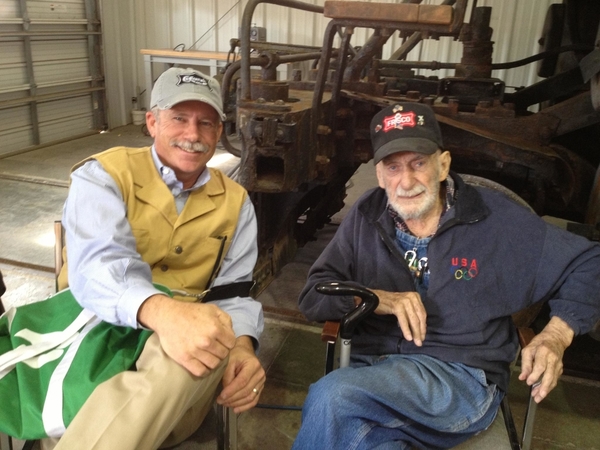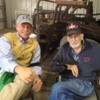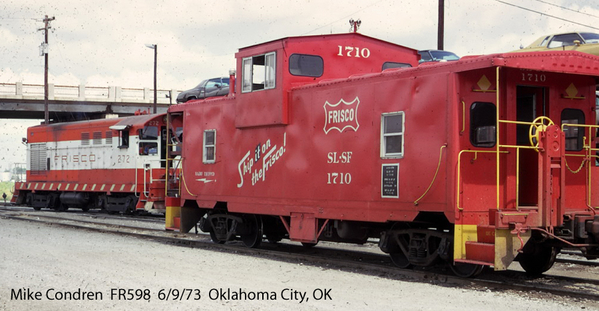In September of 1993 we ran a number of trips with NKP 765 on CSX. They included a trip on the former B&O out of Akron, Ohio to Pittsburgh. The place where we stored the train in Akron was a spot called "The hole" by the CSX crews. Situated about 50 feet below the main line, which is up on a high fill in this location, it's nothing more than a very small yard with a wye at the east end. On the Saturday trip, after the passengers had gotten off the train, we backed the train down the steep grade into the hole, where a CSX diesel tied onto the rear. We cut away and they dragged the train back far enough so we could turn the 765 on the wye and duck into a siding for the night. The diesel then shoved the train forward and the CSX yard crew used it to spot the train for watering the air conditioners from a fire hydrant near the wye. This is typically a very slow process and it was approaching midnight, so we headed off to the motel for a nights rest.
When we showed up around 6:30am the next morning, the first car of the train was spotted right near the fire hydrant in a perfect spot for us to couple on and pump up the air. I was running the eastbound trip this morning and Kim Besecker was firing. We pulled out of the siding, backed up to the train, tied on and got the air pumped up. We did the terminal air test and were all set to go. All this time I assumed that the diesel was still on the rear to help us out, because there was a short but very steep grade to get out of "The hole" and up to the main line. When Ken Griffin, the CSX Trainmaster, said we were all set to go, I asked him if the crew on the diesel was ready to shove. He said, "What crew? There ain't nobody back there. That crew went home around 4am."
So...here we were with a "cold" engine, arch bricks cold, superheaters cold and a thin fire because Kim had just cleaned it. But the 765 was going to have to go all out to get this train out of the hole and up this "ramp" to the main line! Complicating things was the fact that we had a 29 car train behind the 765! I called Kim over to my side of the cab and told him what we were going to have to do. He said, "Give me about 5 minutes to get the fire in shape for this." He proceeded to take the shovel and build a good heel of coal in the back corners of the firebox. He then ran the stoker for a few moments to put another layer of coal on the fire bed, to thicken the entire fire just a bit. In five minutes the pops were sizzling and he gave me the high sign that he was ready to go.
We were literally 4 car lengths from where this grade started. There was no chance at all to run for the hill. I dropped the Alco Power Reverse down in the forward corner, opened the cylinder cocks, turned the sanders on full, released the brakes and carefully opened the throttle. We had moved only a couple feet when we got the word from the rear that we were "All movin!'" That meant that all the slack was stretched and I could open the throttle a bit more without yanking the train in two. By the time we had moved one full engine length and I had the 765's throttle wide open! The sound was deafening! Each exhaust was like a cannon shot going off! The 765 leaned into the grade without so much as a quarter slip, accelerating as best she could with a 29 car train behind her. We got up to about 6 or 7 mph, but with each turn of the drivers we pulled more of the train onto the grade. Slowly but surely the speed dropped until we reached a point where there was more than a second between each exhaust! The column of smoke from the stack was blasting over a hundred feet into the air. We were going so slowly that I could actually feel engine gently lunge forward as the steam admission port opened on each stroke!
Operating this slowly, with maximum throttle and cutoff, full boiler pressure was being used in the cylinders. I had the throttle wide open, the sanders on and the reverse down in the corner...I couldn't do any more than that. In a situation like this, it's actually in the fireman's hands as to whether you make it or not. If Kim let the steam drop back just a couple of pounds, we would stall. But he's one of the best fireman I've ever seen, and it looked like he had the steam gauge welded on 245!
Wham......wham.......wham......that sharp, Baker-timed cannon-shot exhaust kept blasting to the beat of a very slow drummer. Ever so slowly we dragged that big 29 car train up and out of the hole. All the while I was ready with both hands on the throttle in case we slipped, because if we so much as quarter slipped, we would have stalled. But the 765 hung in there and never slipped once! We made it, but this was the hardest pull I've ever seen with the 765. They made 'em good in Lima.
When we got to the switch to the main line, the CSX conductor was standing on the ground at the switch stand. His eyes were the size of pie plates and you could have put a football in his mouth! No diesel had ever put on this kind of show!
After getting the train up on to the main line, we had to back up about 2 miles to the boarding site at Quaker Square in Akron. When we spotted the train for boarding, I got down from the cab to say hello to my friend Terry Ludban. Terry was the local CSX Operation Lifesaver representative and we had worked on many Operations Lifesaver videos together. As we shook hands, Terry said, "You guys had to yank that train up out of the hole, didn't you?" I replied, "Yeah! how did you know that?" Terry said, "We could hear you!"
Believe it or not, the CSX conductor manning the switch at the top of the hill was the only person to see this show. There was no one else there! No railfans, no still pictures, no videos - nothing but this wonderful memory, plus the pictures and sounds in my mind.








